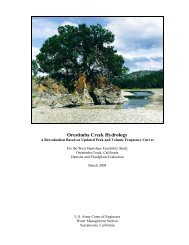Orestimba Creek Feasibility Study - Stanislaus County
Orestimba Creek Feasibility Study - Stanislaus County
Orestimba Creek Feasibility Study - Stanislaus County
You also want an ePaper? Increase the reach of your titles
YUMPU automatically turns print PDFs into web optimized ePapers that Google loves.
Economics Appendix – Draft Report - <strong>Orestimba</strong> <strong>Creek</strong> <strong>Feasibility</strong> <strong>Study</strong>, <strong>Stanislaus</strong> <strong>County</strong>, California – September 2012<br />
• The minority population percentage of the affected area is meaningfully greater than the<br />
minority population percentage in the general population or other appropriate unit of geographic<br />
analysis.<br />
The same rule would apply to the presence of a low-income population. A low income<br />
population is present if the project study area is composed of 50 percent or more people living<br />
below the poverty threshold, as defined by the US Census Bureau, or is significantly greater than<br />
the poverty percentage of the general population or other appropriate unit of geographic analysis.<br />
The second step of an environmental justice analysis requires a finding of a high and adverse<br />
impact, which is discussed below.<br />
Basis of Significance<br />
While there are no laws specifically associated with limits to socioeconomic impacts, and<br />
environmental justice, (EO 12898) and (EO 13045) speaking to the health effects on children are<br />
addressed below. The executive orders address the impacts on the demographic, economic, and<br />
social factors that could measurably alter the economic conditions (the availability of<br />
employment and income), the accessibility of goods, infrastructure, and services, and the quality<br />
of life in the area of influence. These types of impacts would be significant to the affected<br />
population. More specifically, a proposed project alternative would have a significant<br />
socioeconomic impact if it were to result in any of the following effects:<br />
• Long-term increase in population that could not be accommodated by regional<br />
infrastructure (for example, housing, utilities, roads, hospitals, and schools) or services<br />
(such as police and emergency services);<br />
• A reduction in the availability of affordable housing (which could occur either through<br />
a large increase in housing prices or a large decline in the supply of affordable housing);<br />
• Long-term displacement of population that could not be accommodated within the<br />
region;<br />
• Long-term displacement or disruption of local businesses that could not be<br />
accommodated within the region;<br />
• A loss in community facilities, events, population, or major industry that would result in<br />
an overall loss in community cohesion; or<br />
• Disruption of emergency services or creation of a public health risk that could not be<br />
avoided by the public, especially if it would particularly affect the health and safety of<br />
children.<br />
Likewise, a proposed project alternative would have an environmental justice impact if it were to<br />
cause impacts that are “disproportionately high and adverse,” either directly, indirectly, or<br />
108
















